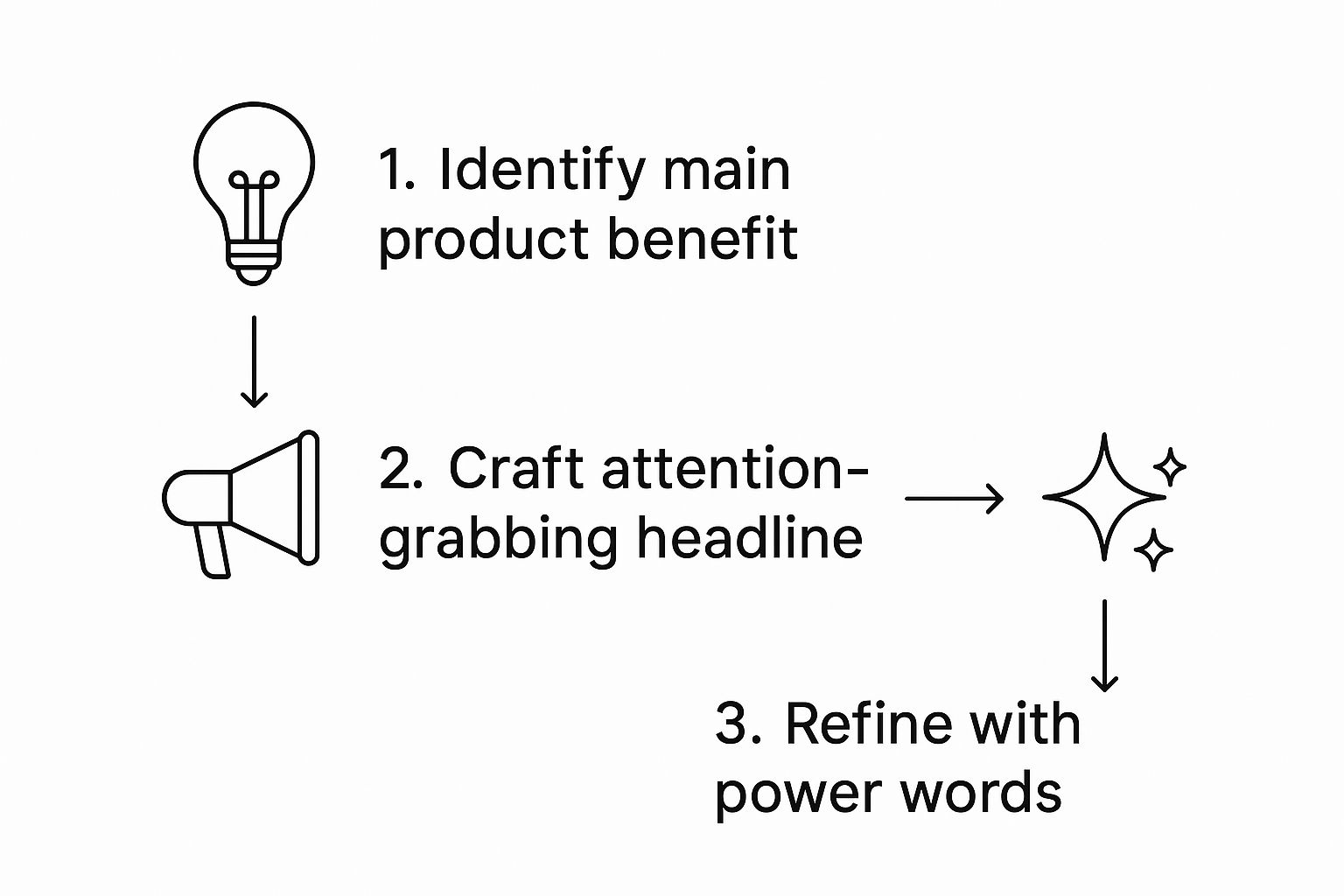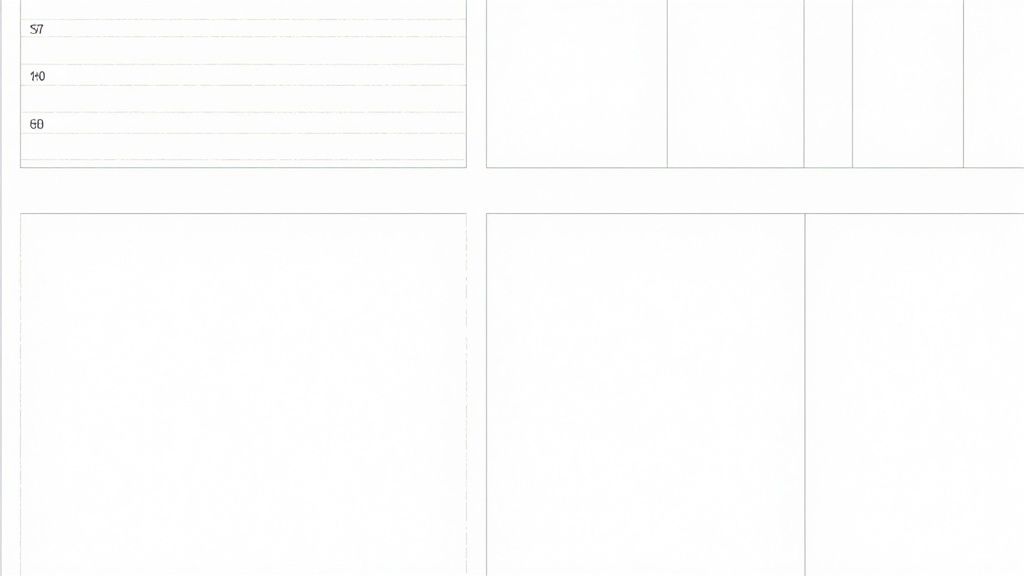How to Write Product Descriptions That Boost Sales

Writing a product description is all about one thing: translating a list of features into benefits that solve a real problem for your customer. The best copy zeroes in on the outcome—the feeling your product delivers—not just its technical specs. It's the classic difference between selling a memory foam mattress and selling a perfect, restorative night's sleep.
Why Your Product Descriptions Are Losing You Sales

Let's be real for a second. Most product descriptions are just… noise. They often feel like an afterthought, slapped together from a manufacturer's spec sheet and loaded with jargon or empty phrases like "excellent quality." This doesn’t just bore your audience; it actively costs you money. It introduces doubt right at the finish line of their buying journey.
When a description is weak, it leaves potential customers with unanswered questions. This forces them to click away to find clarity somewhere else—usually on a competitor's site. It completely fails to build that crucial emotional connection that turns a casual browser into a committed buyer. Think of it as a leak in your sales funnel, and it's a big one.
The Real Impact of Compelling Copy
Great product copy does so much more than describe. It persuades. It’s your best salesperson, working 24/7 to connect a customer’s problem with your product’s solution. Get this right, and you'll see a dramatic improvement across your key ecommerce metrics.
Here’s what a truly effective description actually does for you:
- Builds Trust: When you provide clear, honest, and detailed info, you knock down buyer uncertainty and instantly establish credibility.
- Reduces Returns: Customers who know exactly what they’re getting have their expectations met. That means fewer frustrating and costly returns.
- Improves SEO: Thoughtfully written copy naturally weaves in the keywords real people are using to find products just like yours.
- Justifies Price: Strong copy is all about articulating value. It makes a higher price point feel not just reasonable, but completely justified.
Here's a practical look at how to stop listing specs and start selling solutions your customers actually care about.
From Feature to Feeling: The Benefit Transformation
| Dry Product Feature (What it is) | Compelling Customer Benefit (What it solves) |
|---|---|
| 10,000 mAh battery | Stay powered all weekend long. Never miss a photo or lose directions because your phone died on the go. |
| Gore-Tex waterproof fabric | Hike through any storm and stay bone dry. Don't let a little rain ruin your adventure. |
| Noise-canceling headphones | Find your focus anywhere. Block out distractions on your commute or in a busy office and get in the zone. |
| Non-stick ceramic coating | Spend less time scrubbing and more time enjoying your meal. Effortless cleanup, every time. |
See the difference? One is a technical detail; the other is a solution to a real-life frustration. That's where the magic happens.
The words on your product page are one of the most critical elements in the purchase decision. They are the final pitch before a customer decides to add an item to their cart or abandon it entirely.
The data absolutely backs this up. High-quality product descriptions are a massive driver for conversion rates. Research shows that nearly 90% of consumers say product content is extremely important when they’re deciding what to buy. You can learn more about the impact of copywriting on market trends to see just how deep this goes.
Ultimately, investing time in your product descriptions isn't just a writing exercise. It's a core business strategy that directly shapes customer perception, trust, and your bottom line. It’s about showing people you understand their needs and have the perfect solution ready and waiting.
Thinking Like a Customer Before You Write Anything
Look, the best product descriptions aren't just about fancy words or clever marketing slogans. They come from a place of genuine customer understanding. Before a single word hits the page, you have to get out of your own head—the head of a seller—and step directly into the mind of your buyer.
This isn't some fluffy, optional step. It’s the foundational work that separates copy that merely describes a product from copy that actually sells it.
Your mission is to know your customer so well that when they read your description, it feels like it was written specifically for them. This goes way beyond basic demographics. You need to dig into their real-world problems, their hopes, and what they’re truly trying to achieve with a product like yours.
Build a Practical Buyer Persona
A buyer persona isn't just a made-up character to tack onto a marketing plan. Think of it as a practical tool, a compass that guides every single word you write. It transforms a vague "target audience" into a real person you can have a conversation with. A solid persona helps you lock in the right tone of voice and highlight the benefits that truly matter.
And this doesn't have to be some massive, time-consuming project. Just start by asking a few focused questions:
- What’s their biggest frustration right now? (e.g., "My current water bottle leaks all over my gym bag.")
- What’s the ultimate dream outcome for them? (e.g., "I want a reliable, stylish bottle that keeps my water ice-cold through a long workout.")
- What makes them hesitate before buying? (e.g., "Is this really worth the price? Is it a pain to clean?")
The answers to these questions are pure gold. They give you the raw material to craft benefit-driven copy that connects. For a more detailed walkthrough, our guide on how to create buyer personas offers a step-by-step process to really sharpen your focus.
Uncover the Voice of Your Customer
Want to know the most authentic and convincing language you can possibly use? It’s your customers' own words. Your job is to become an expert listener and find out where your audience is already talking about their problems and needs.
This is where you'll find those little nuggets of copy that resonate instantly.
Start digging into these key sources:
- Customer Reviews: Don't just skim them. Scour your own reviews and, just as importantly, your competitors'. Look for repeated phrases, specific compliments, and detailed complaints.
- Social Media Comments: Pay attention to comments on your posts, brand mentions, and discussions happening in relevant Facebook groups or Reddit forums.
- Surveys & Feedback: Just ask! Send a quick survey to your existing customers asking what they love about your product and, more specifically, what problem it solved for them.
By listening to your audience, you're not just gathering data; you're harvesting the exact words and phrases that will make your future customers feel understood. This is the secret to building instant rapport and trust.
Honestly, this research phase is the most important part of the entire process. Don't skip it. It ensures that when you finally do start writing, you’re not just guessing what your customers want to hear. You’ll know.
Crafting a Description That Converts
Alright, you’ve done your homework and know your customer inside and out. Now for the fun part: writing the actual description. A product description that truly sells isn't just a list of specs thrown on a page. It's a thoughtfully constructed piece of copy designed to walk a potential buyer from casual interest to absolute certainty.
Think of each part as having a specific job. The headline needs to stop their scroll. The opening has to connect with them on a personal level. And the bullet points need to close the deal. It’s less about just writing and more about building a persuasive argument, one line at a time. This shift in perspective is what separates copy that simply informs from copy that drives sales.
Grab Attention with a Powerful Headline
Your headline is your digital storefront window—it’s the first thing people see, and it might be your only shot to pull them in. It needs to be packed with a benefit and spark enough curiosity to make them stop.
So, instead of a boring, literal name like "Leather Tote Bag," go for something that hints at an outcome. Try "The Effortless Tote That Carries Your Entire Day." See the difference? The second one immediately positions the bag as a solution, not just another product. If you're looking to sharpen these fundamental skills, our guide on https://www.lumeo.me/en/blog/copywriting-for-beginners is a fantastic place to start.
Hook Them with a Problem-Focused Opening
Once you have their attention, the opening paragraph has to make an instant connection. The fastest way to do this? Speak directly to the problem that’s been bugging them. Show them you get it before you even start talking about your product.
Let's say you're selling a travel backpack. You could open with something like: "Tired of choosing between a bag that’s organized and one that’s actually comfortable to carry? We believe you shouldn't have to compromise." This immediately shows empathy, tells the customer you understand their pain point, and perfectly sets the stage for you to introduce the solution.
Your product description isn't just a sales pitch; it's a conversation. It should start by acknowledging the customer's world, making them feel seen and understood before you ask for the sale.
This simple flow—problem, agitation, solution—is a classic for a reason. It just works.

This visual breaks it down perfectly. A great description starts with a core benefit, gets framed by a killer headline, and is polished with persuasive, customer-focused language.
Sell the Dream with Scannable Bullet Points
Let’s be honest: most people online are scanners, not readers. They’re looking for the highlights. This is exactly why crisp, benefit-driven bullet points are your secret weapon. Use them to translate your product's features into a vision of a better, easier life for your customer.
Instead of: "Made from waterproof nylon."
Try: Never worry about sudden downpours again. Your laptop and essentials stay completely dry, no matter the weather.
Instead of: "Ergonomic shoulder straps."
Try: Commute in total comfort. Our padded straps are designed to eliminate shoulder strain, even when your bag is fully packed.
Mastering this skill is more important than ever. The demand for writers who can craft copy that actually converts is exploding, with the global content writing market projected to hit USD 38.6 billion by 2033. This isn't just a "nice to have" skill anymore; it's a critical driver of growth. If you want to see how the pros do it, check out these compelling ad copy examples for a masterclass in persuasion.
The High-Conversion Product Description Checklist
To make sure you're hitting all the right notes, I've put together a quick checklist. Run your descriptions through this before you hit publish to ensure they're primed for performance.
| Element | What It Does | Pro Tip |
|---|---|---|
| Benefit-Driven Headline | Grabs attention and promises a valuable outcome. | Focus on the end result for the customer, not the product's name. |
| Problem-Focused Opening | Builds an immediate connection and shows empathy. | Start by describing a pain point your ideal customer experiences. |
| Solution-Oriented Body | Introduces the product as the hero that solves the problem. | Bridge the gap between their problem and your product's solution. |
| Scannable Bullet Points | Translates features into tangible benefits for easy reading. | Use the "So you can..." framework. Feature so you can benefit. |
| Social Proof/Testimonial | Builds trust and credibility with third-party validation. | A short, impactful quote is often more powerful than a long story. |
| Clear Call-to-Action (CTA) | Tells the customer exactly what to do next. | Use strong, direct action words like "Add to Cart" or "Get Yours Now." |
Using this checklist helps you move from just describing a product to truly selling the experience. It ensures every word has a purpose and works toward the ultimate goal: turning a browser into a buyer.
Weaving SEO and Persuasion Together

Crafting a beautiful, persuasive product description is only half the job. Let's be honest: if your customers can't find your product on Google, even the most compelling copy is just shouting into the void.
This is where search engine optimization (SEO) enters the picture, but it's a delicate dance. The real goal is to get search engines on your side without making your descriptions sound like they were written by a keyword-obsessed robot.
The secret? Always write for people first. Google's entire mission is to help people find what they're looking for. When your copy genuinely helps a buyer by being clear, useful, and informative, you're already playing the SEO game right. Forget trying to "trick" the algorithm.
Finding the Keywords Your Customers Actually Use
Before you can start optimizing, you need to get inside your customers' heads. What words are they actually typing into that search bar? This isn't a guessing game; it's research. A good keyword research tool can show you the exact phrases people use when they have a problem your product is built to solve.
You'll want to zero in on long-tail keywords. These are longer, more specific phrases that show someone is serious about buying. Think "waterproof hiking boots for wide feet" instead of just "boots." That first searcher isn't just browsing; they have a specific need and are much closer to making a purchase.
Once you nail down your main keyword, find a few related secondary keywords to sprinkle in. This helps you build out rich, relevant copy that gives search engines a much clearer picture of what your product is all about.
How to Weave Keywords into Your Copy Naturally
With your keywords in hand, the next step is placing them strategically. The key here is to make it feel completely effortless and natural. Jamming keywords everywhere—a practice called keyword stuffing—is a fast track to getting penalized by Google and, worse, annoying your potential customers.
Here's a quick checklist for natural keyword placement:
- Product Title (H1): This is prime real estate. Make sure your primary keyword is part of the title.
- Body Copy: Aim to mention your main keyword once or twice within the main description, ideally somewhere near the beginning.
- Image Alt Text: This text describes your product image for visually impaired users and search engines. It's a perfect spot for your keyword.
- URL: A clean, keyword-rich URL helps both people and search engines understand the page's content at a glance.
The meta description—that little snippet of text under your title in search results—is your sales pitch to get the click. While it doesn't directly boost your rankings, a compelling, keyword-rich meta description can dramatically increase your click-through rate.
Take a real-world example: the product "Biossance Squalane + Vitamin C Rose Oil." The keyword is right there in the name. You'll see it in the title, the URL, and mentioned naturally throughout the description. This approach is powerful because it perfectly aligns with what both shoppers and search engines expect to find.
Remember, the goal isn't just to rank; it's to attract the right kind of traffic—the people who are actually ready to buy.
Using AI as Your Creative Assistant, Not Your Replacement

AI writing tools are popping up everywhere in ecommerce, but there's a huge difference between using them smartly and just letting them take over. The best approach is to treat AI as a tireless creative assistant, not as the final writer.
Think of it as your ultimate brainstorming partner. It’s fantastic for spitting out initial drafts, smashing through writer's block, and suggesting creative angles you hadn't even considered. You can ask it for five different versions of a description in seconds to see which tone hits the mark, saving you a ton of time.
Smart Prompts for Better AI Output
The quality of what you get out of an AI tool is a direct reflection of the instructions you feed it. Vague prompts get you generic, boring copy. Specific, detailed prompts are where the real magic happens.
So, instead of a lazy prompt like, "product description for a coffee mug," you need to get more granular.
Try something like this:
"Write three product descriptions for a 16 oz insulated coffee mug. The target audience is busy urban commuters. Adopt a witty and slightly sarcastic tone. Focus on the key benefits: it keeps coffee hot for 6 hours, is completely spill-proof for crowded trains, and has a sleek matte black finish. End with a strong call to action."
This level of detail gives the AI clear guardrails. The result? Focused, usable first drafts that you can actually work with and refine. For those looking to go even deeper, plenty of great AI content creation tools can speed this process up.
The Critical Role of the Human Editor
Here's the most important rule of thumb: AI should never have the final word. An AI-generated description is a starting point, not the finished product. It simply can't replicate your brand’s unique personality or the nuanced emotional hooks that actually sell.
Your job is to take that raw material and breathe some life into it.
During the editing process, you need to:
- Inject Brand Voice: Does it actually sound like you? Tweak the words, the rhythm of the sentences, and the overall tone until it perfectly matches your brand's personality.
- Verify Accuracy: AI can and will make things up. Always fact-check every single feature and claim. Your customers' trust depends on it.
- Add Emotional Nuance: This is where you really earn your keep. Weave in sensory words, tiny stories, and relatable feelings that an algorithm could never dream up. This is what builds a connection.
This human oversight is absolutely non-negotiable. Today, about 25% of marketers use AI for product descriptions, and even big players like eBay are integrating AI to auto-generate listings. This shows the drive for efficiency, but it’s that final human touch that guarantees quality.
Think of AI as the sculptor’s apprentice who roughly carves the block of marble. It’s up to you, the master sculptor, to chisel the fine details, create the expression, and bring the final piece to life.
By exploring the broader world of AI for content creation, you can find even more ways to use this tech as a co-pilot. When you combine AI's incredible speed with your own strategic and emotional intelligence, you build a workflow that's not just efficient—it's incredibly effective at writing descriptions that actually convert.
Answering Your Top Product Description Questions
Even when you have a solid plan, you're bound to run into a few tricky questions when you're deep in the writing process. Working through these common hurdles is what separates decent copy from descriptions that genuinely sell. Let's dig into some of the most frequent questions that come up.
Getting these right helps you build a consistent, effective approach, making sure every description you write is fine-tuned to connect with customers and boost your sales.
What Is the Ideal Length for a Product Description?
Sorry, there’s no magic number here. The right length is all about your product's complexity and what your audience needs to know. A simple, everyday item like a t-shirt probably just needs a few catchy lines and a quick bulleted list to get the job done.
But if you're selling a high-tech drone or a specialized piece of software, you'll need a lot more detail to build trust and overcome any hesitation. My go-to advice is to be as long as necessary and as short as possible. Give customers every bit of info they need to feel confident hitting "buy," but lay it all out in a super scannable way so it never feels like a wall of text.
How Can I Make a Seemingly Boring Product Sound Exciting?
Here's a secret: no product is actually "boring" if it solves a real problem for someone. The key is to stop talking about the item and start focusing on the outcome it creates. You’re not just selling a filing cabinet; you're selling the incredible feeling of a perfectly organized office and the peace of mind that comes with it.
Use a bit of storytelling to paint that picture. Who is using this product? How does it make their day easier, better, or more secure? A dash of personality or even some light humor (if it fits your brand) can turn a purely functional item into something people feel they need.
Every product has a story. Your job is to find the human element—the relief, the joy, the satisfaction—that your product creates and put that at the forefront of your description.
This is how you create an emotional connection that makes even the most practical products feel compelling.
What Are the Biggest Mistakes to Avoid?
I see the same handful of mistakes over and over again. Just avoiding these common traps will instantly put your copy head and shoulders above the competition and stop you from losing sales at the finish line. The big ones are:
- Only listing features: Saying "100% cotton" isn't enough. You have to translate that into a benefit, like "Stay cool and comfortable all day long."
- Using empty jargon: Words like "high-quality" are totally meaningless without proof. Don't just tell them it's great; show them why.
- Sounding generic: If your copy could be pasted onto a competitor's site without anyone noticing, it’s not working hard enough for your brand.
- Ignoring basic SEO: Forgetting to use the keywords your customers are actually searching for is like having an invisible product.
- Publishing typos and errors: Nothing tanks your credibility faster than sloppy writing. Proofread. Then proofread again.
Should I A/B Test My Product Descriptions?
Yes, absolutely. A/B testing is one of the most powerful tools you have for improving your conversion rates. Your job isn't done the moment you hit "publish." Think of your copy as a living document that should constantly be refined based on real data.
Try testing different headlines, calls-to-action, the order of your bullet points, or even the entire tone of voice. You’d be shocked at how a tiny tweak—like changing one word in a headline—can create a major lift in your add-to-cart rate. Most e-commerce platforms have built-in tools for this, so let your customers' actions show you what copy really works best.
Ready to transform your content into visually stunning carousels that captivate your audience? With Lumeo, you can effortlessly create engaging presentations from any text, video, or article. Start building your brand and boosting engagement today. Discover how Lumeo works